About Zarda Recipe
Zarda pulao is so named because the word zard means ‘yellow’ in Persian and Urdu languages. Typical zarda pulao has a yellow color from using yellow food color. In my Zarda Recipe, I have used saffron to get that sunshiny color and have not used any artificial colors whatsoever. Zarda rice is made during festive occasions in our home. This is my mother-in-law’s recipe and it has become my go-to for this delicious dish. The method shared here is easy and not difficult. Love sweet or subtly spiced rice dishes? Try our Jaggery Rice & Kashmiri Pulao next! There are many variations of making zarda pulao in India as well as in neighboring countries like Bangladesh and Pakistan. What I am sharing here is how we make Zarda at home and it may not be considered authentic by all parties. That said, it’s super delicious. This Zarda recipe yields a really delicious sweet rice that will be loved by both grown-ups and kids. There are various dry fruit and nuts that you can add to the rice. I have used a mix of cashews, almonds, and pistachios. Raisins are also often added, but I didn’t have any the day I made this batch. Do add raisins if you have them, as they add lovely pops of sweet and chewy texture throughout. Serve Zarda Rice as a sweet snack or a dessert. The recipe can easily be doubled or tripled according to your needs.
Ingredients & Substitutions
Basmati Rice – I love fragrant basmati rice for just about every recipe. That said, feel free to use any long grain rice you have on hand (e.g. jasmine).Cloves – I use whole cloves here for the most potent flavor. In a pinch, you can swap in ground cloves.Saffron (Kesar) – For bright yellow coloring and a bit of flavor.Water – If possible, use filtered water for the best flavor.Ghee (Clarified Butter) – For richness. If you prefer to make this vegan, swap in edible coconut oil or vegan butter.Green Cardamom Powder – For warmth.Sugar – For sweetness. Feel free to use jaggery, cane sugar, or any other sweetener you prefer.Almonds, Cashews & Pistachios – Any variety of toasted nuts can be used here. You can also substitute seeds like pepitas (pumpkin seeds) or sunflower seeds if you are a nut-free household. Alternatively, omit them altogether.Raisins – These are my most used dried fruit, but feel free to use any that you and your family prefer.
How to make Zarda Rice
This beautiful meethe chawal comes together without much fuss. Here’s how it’s done:
Pressure Cook Rice
- Rinse ½ cup basmati rice very well in water till the water runs clear of starch. Then soak basmati rice for 20 to 30 minutes in enough water. After 20 to 30 minutes drain all the water and keep the rice aside.
- In a 2 litre pressure cooker, pour 1 cup water.
- Add ⅛ teaspoon saffron strands (3 to 4 pinches of kesar).
- With a spoon, stir so that the saffron strands mix with water.
- Then add ½ cup of the soaked basmati rice.
- Add 5 to 6 cloves. You can even add 7 to 9 cloves if you prefer.
- Pressure cook for 2 whistles or for about 6 to 7 minutes on medium heat.
- Once the pressure settles down, then open the lid and check the rice if its cooked.
- The rice just needs to be cooked. Gently fluff the rice. You can also opt to cook the rice grains until they are al dente.
Make Zarda Pulao
- In a heavy kadai or pan, add 3 tablespoons ghee.
- With a spoon or spatula spread ghee on all sides of the pan. This is done so that the rice grains do not stick to the pan when cooking.
- Add the cooked rice in the pan.
- Add ½ cup of sugar.
- Sprinkle ¾ teaspoon green cardamom powder. You can also add 1 teaspoon cardamom powder for a more pronounced cardamom aroma.
- Mix well but gently, so that the sugar gets mixed evenly with cooked rice grains.
- On a low flame or low heat, cook the sweet rice mixture. You will see the sugar melting and some liquid consistency in the rice.
- Stir the zarda rice mixture occasionally.
- Cook till the sugar solution dries up. If the rice grains feel hard, chewy or dense after cooking, then cover the pan with a damp cloth or moist cotton napkin. Then cover with a lid and cook zarda pulao for 20 to 30 seconds on low heat.
- Once there is no liquid consistency in the sweet rice, then add 8 pistachios (sliced), 8 almonds (sliced) and 8 cashews (sliced). 11. Mix well and turn off the heat. If adding raisins, then you can add at this step.
- Serve Zarda or Meethe Chawal hot or warm. Alternatively, you can spread Sweet Rice on a large plate and then serve. Garnish Zarda Rice with some cashews, raisins, almonds, and pistachios while serving. Enjoy! More Indian rice recipes
Veg pulaoVeg biryaniCurd riceBrinji rice
Please be sure to rate the recipe in the recipe card or leave a comment below if you have made it. For more vegetarian inspirations, Sign Up for my emails or follow me on Instagram, Youtube, Facebook, Pinterest or Twitter. This Zarda recipe from the archives, originally published in June 2017 has been updated and republished on February 2023.
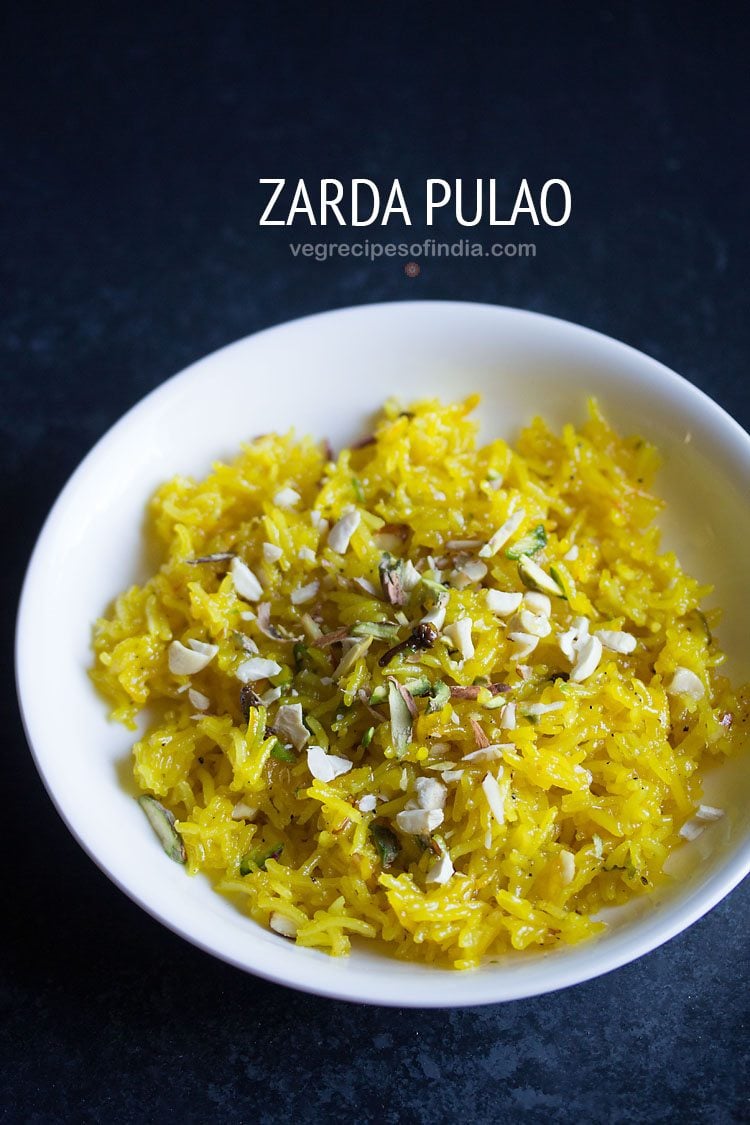
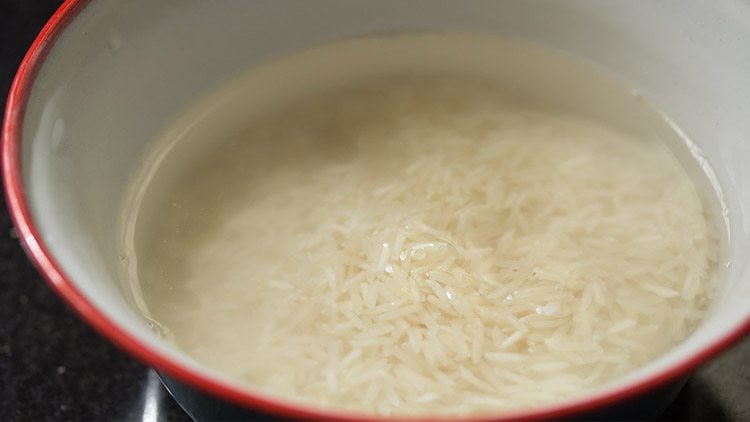
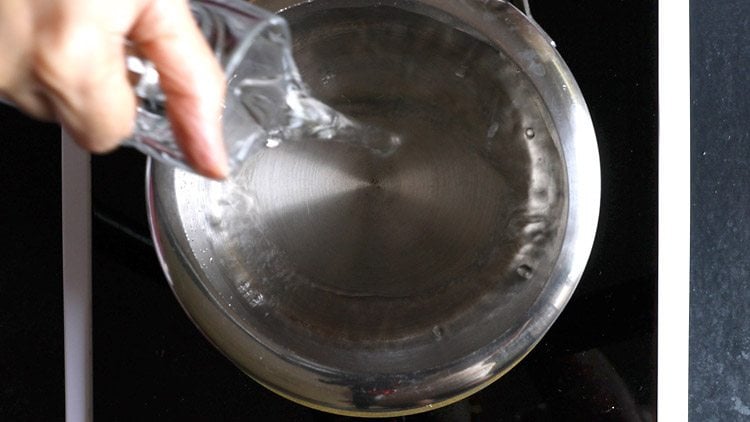
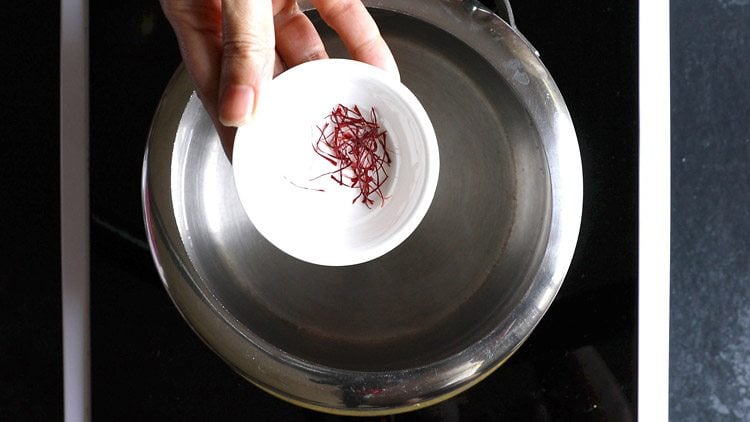
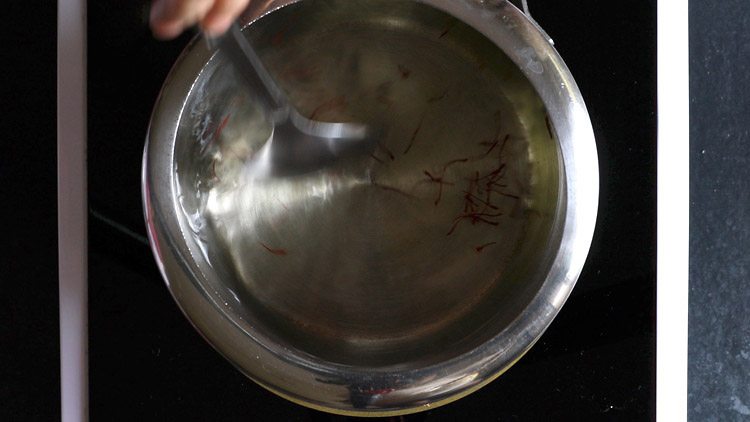
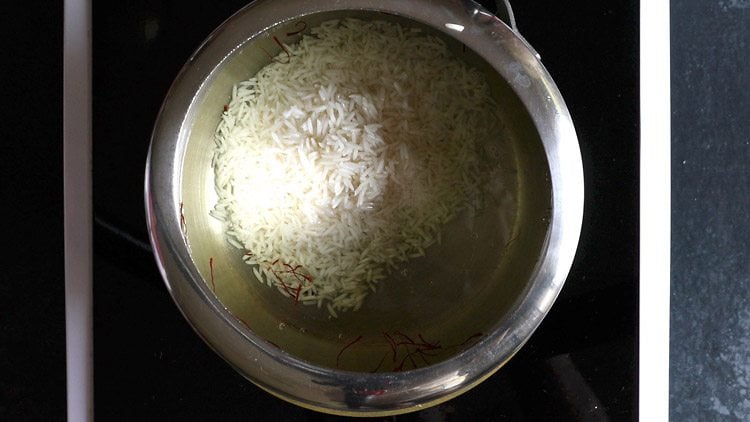
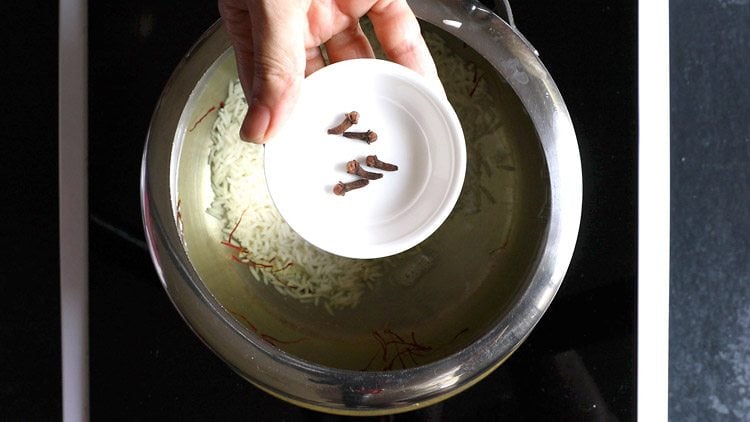
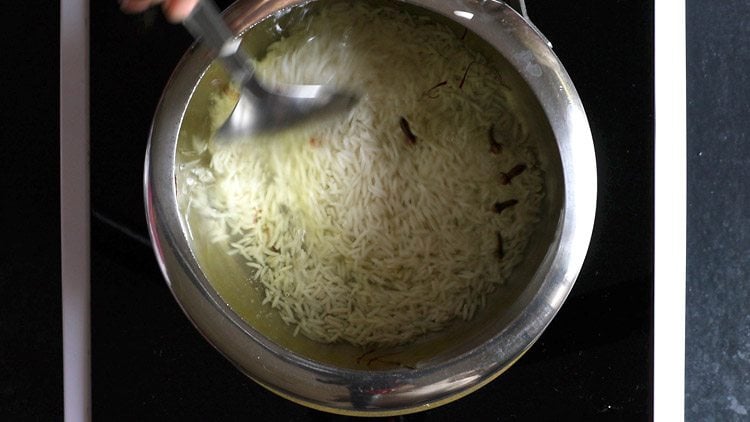
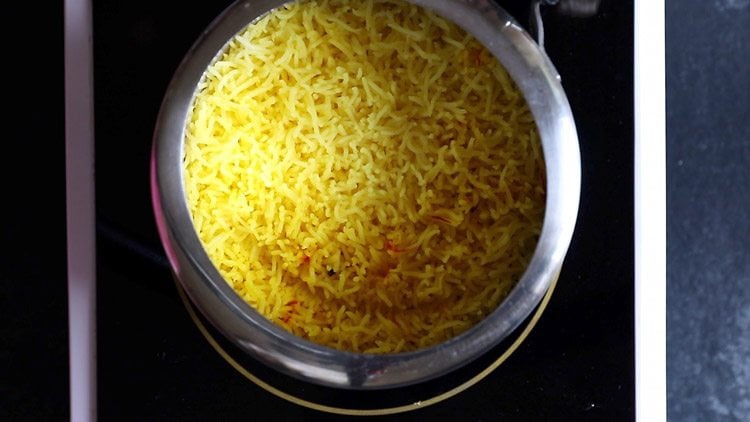
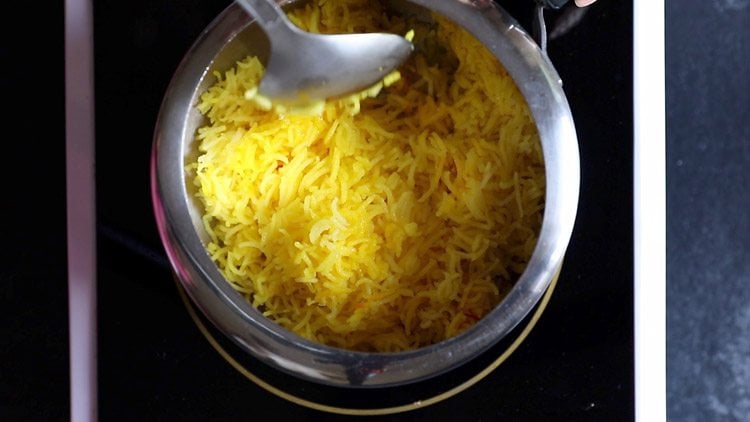
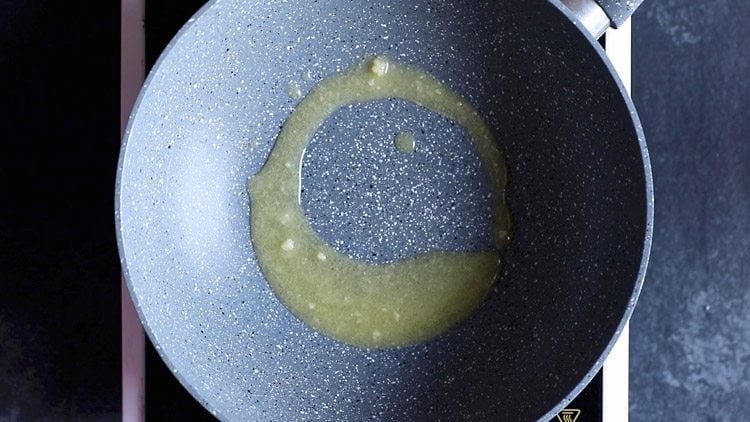
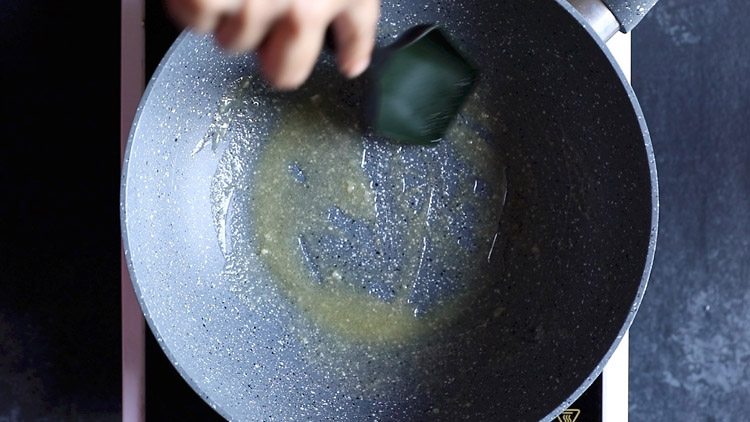
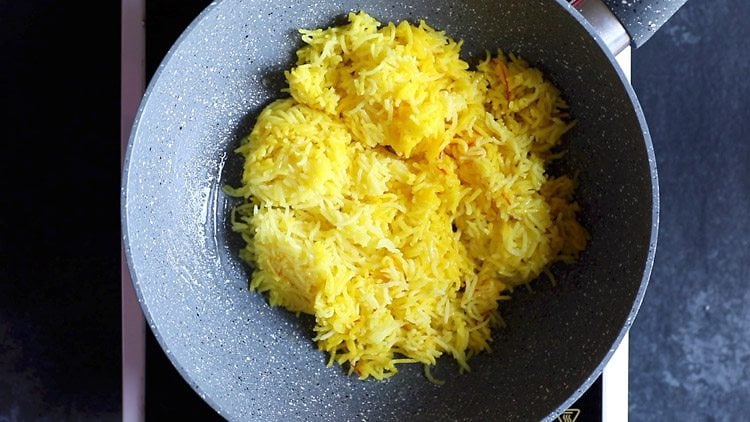
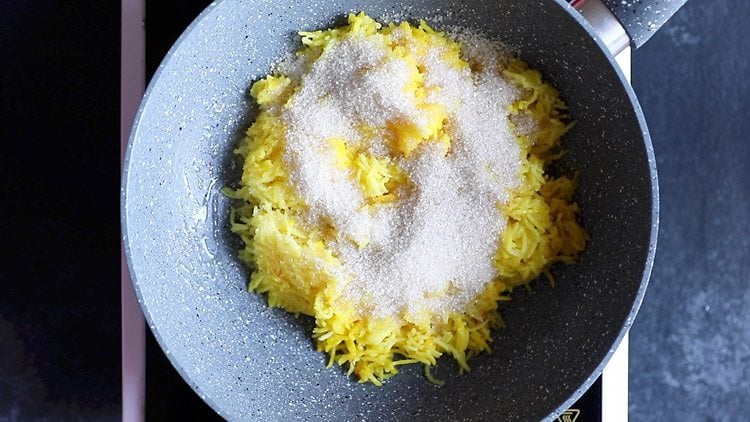

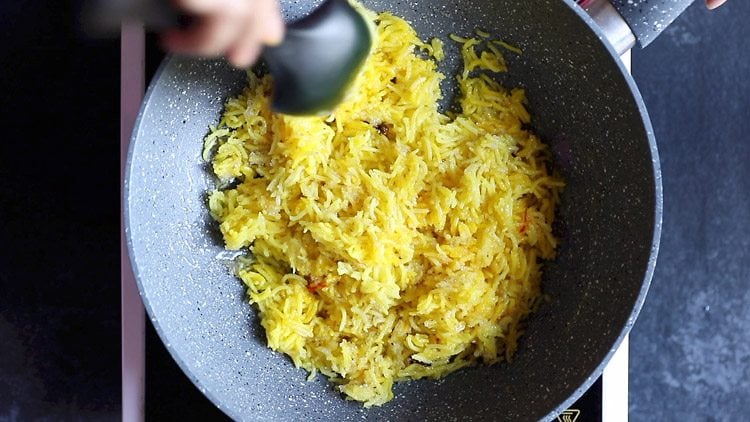
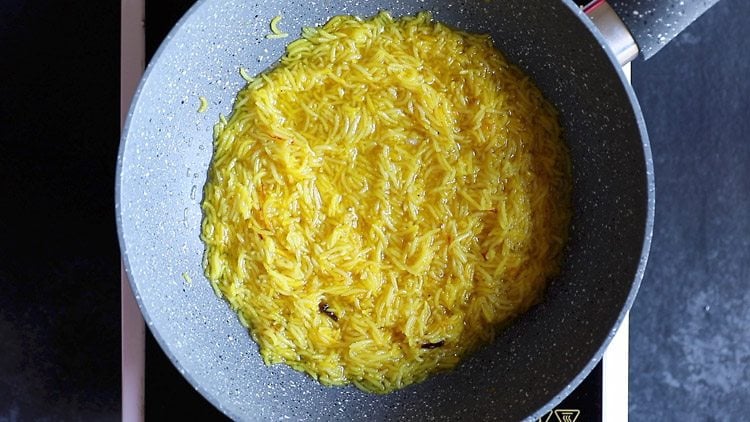

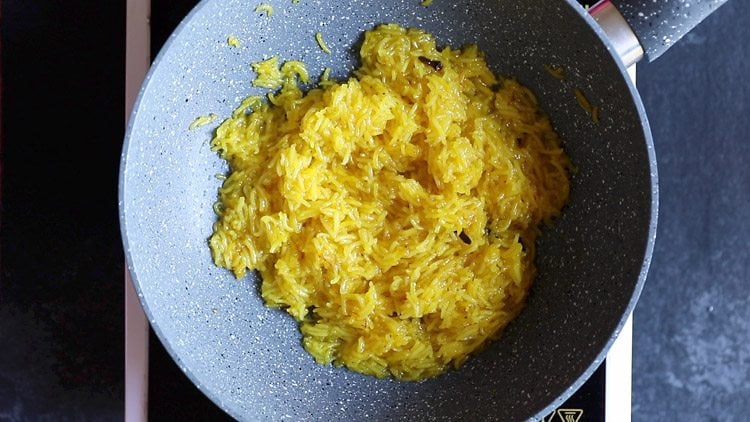
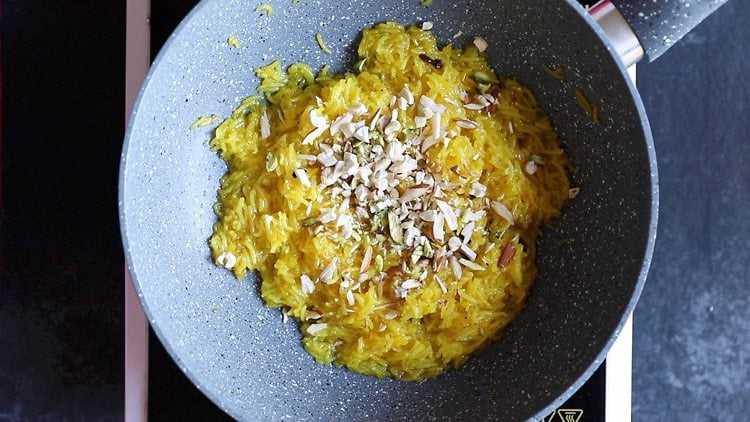
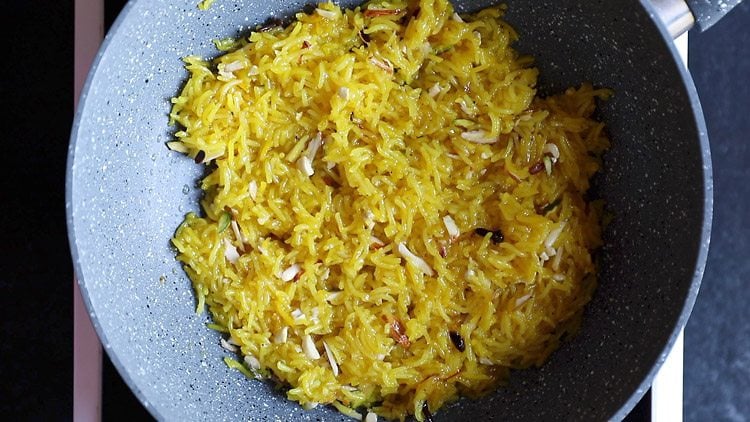
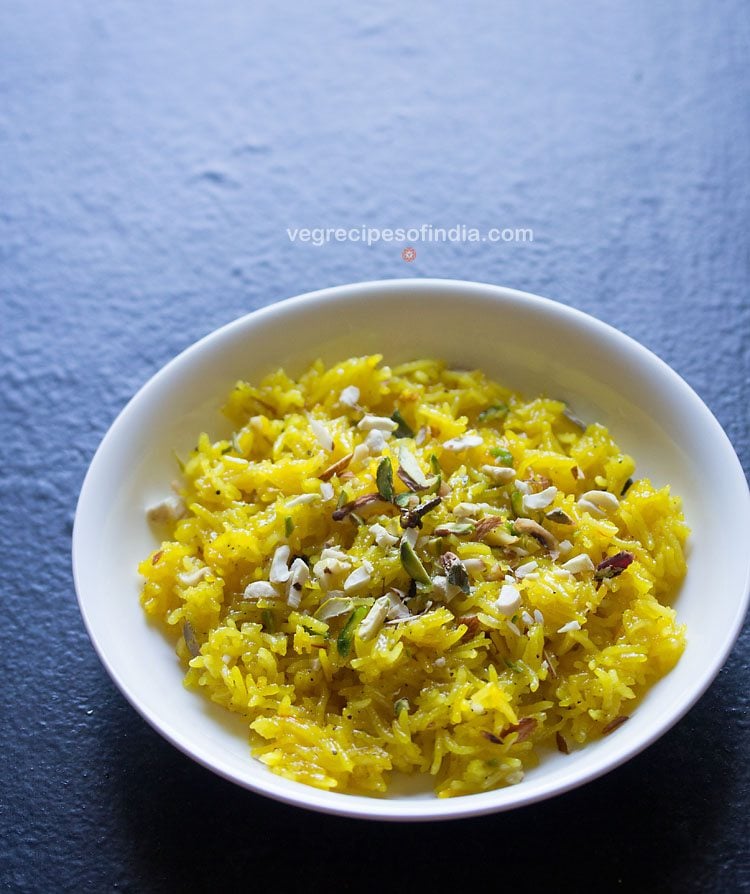
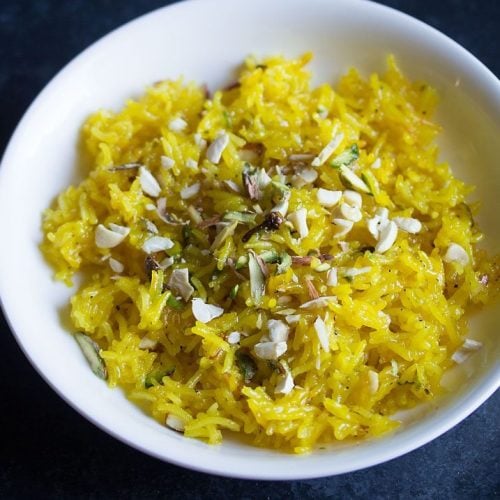
title: “Zarda Recipe Meethe Chawal Indian Sweet Rice " ShowToc: true date: “2024-09-28” author: “Sammie Martir”
About Zarda Recipe
Zarda pulao is so named because the word zard means ‘yellow’ in Persian and Urdu languages. Typical zarda pulao has a yellow color from using yellow food color. In my Zarda Recipe, I have used saffron to get that sunshiny color and have not used any artificial colors whatsoever. Zarda rice is made during festive occasions in our home. This is my mother-in-law’s recipe and it has become my go-to for this delicious dish. The method shared here is easy and not difficult. Love sweet or subtly spiced rice dishes? Try our Jaggery Rice & Kashmiri Pulao next! There are many variations of making zarda pulao in India as well as in neighboring countries like Bangladesh and Pakistan. What I am sharing here is how we make Zarda at home and it may not be considered authentic by all parties. That said, it’s super delicious. This Zarda recipe yields a really delicious sweet rice that will be loved by both grown-ups and kids. There are various dry fruit and nuts that you can add to the rice. I have used a mix of cashews, almonds, and pistachios. Raisins are also often added, but I didn’t have any the day I made this batch. Do add raisins if you have them, as they add lovely pops of sweet and chewy texture throughout. Serve Zarda Rice as a sweet snack or a dessert. The recipe can easily be doubled or tripled according to your needs.
Ingredients & Substitutions
Basmati Rice – I love fragrant basmati rice for just about every recipe. That said, feel free to use any long grain rice you have on hand (e.g. jasmine).Cloves – I use whole cloves here for the most potent flavor. In a pinch, you can swap in ground cloves.Saffron (Kesar) – For bright yellow coloring and a bit of flavor.Water – If possible, use filtered water for the best flavor.Ghee (Clarified Butter) – For richness. If you prefer to make this vegan, swap in edible coconut oil or vegan butter.Green Cardamom Powder – For warmth.Sugar – For sweetness. Feel free to use jaggery, cane sugar, or any other sweetener you prefer.Almonds, Cashews & Pistachios – Any variety of toasted nuts can be used here. You can also substitute seeds like pepitas (pumpkin seeds) or sunflower seeds if you are a nut-free household. Alternatively, omit them altogether.Raisins – These are my most used dried fruit, but feel free to use any that you and your family prefer.
How to make Zarda Rice
This beautiful meethe chawal comes together without much fuss. Here’s how it’s done:
Pressure Cook Rice
- Rinse ½ cup basmati rice very well in water till the water runs clear of starch. Then soak basmati rice for 20 to 30 minutes in enough water. After 20 to 30 minutes drain all the water and keep the rice aside.
- In a 2 litre pressure cooker, pour 1 cup water.
- Add ⅛ teaspoon saffron strands (3 to 4 pinches of kesar).
- With a spoon, stir so that the saffron strands mix with water.
- Then add ½ cup of the soaked basmati rice.
- Add 5 to 6 cloves. You can even add 7 to 9 cloves if you prefer.
- Pressure cook for 2 whistles or for about 6 to 7 minutes on medium heat.
- Once the pressure settles down, then open the lid and check the rice if its cooked.
- The rice just needs to be cooked. Gently fluff the rice. You can also opt to cook the rice grains until they are al dente.
Make Zarda Pulao
- In a heavy kadai or pan, add 3 tablespoons ghee.
- With a spoon or spatula spread ghee on all sides of the pan. This is done so that the rice grains do not stick to the pan when cooking.
- Add the cooked rice in the pan.
- Add ½ cup of sugar.
- Sprinkle ¾ teaspoon green cardamom powder. You can also add 1 teaspoon cardamom powder for a more pronounced cardamom aroma.
- Mix well but gently, so that the sugar gets mixed evenly with cooked rice grains.
- On a low flame or low heat, cook the sweet rice mixture. You will see the sugar melting and some liquid consistency in the rice.
- Stir the zarda rice mixture occasionally.
- Cook till the sugar solution dries up. If the rice grains feel hard, chewy or dense after cooking, then cover the pan with a damp cloth or moist cotton napkin. Then cover with a lid and cook zarda pulao for 20 to 30 seconds on low heat.
- Once there is no liquid consistency in the sweet rice, then add 8 pistachios (sliced), 8 almonds (sliced) and 8 cashews (sliced). 11. Mix well and turn off the heat. If adding raisins, then you can add at this step.
- Serve Zarda or Meethe Chawal hot or warm. Alternatively, you can spread Sweet Rice on a large plate and then serve. Garnish Zarda Rice with some cashews, raisins, almonds, and pistachios while serving. Enjoy! More Indian rice recipes
Veg pulaoVeg biryaniCurd riceBrinji rice
Please be sure to rate the recipe in the recipe card or leave a comment below if you have made it. For more vegetarian inspirations, Sign Up for my emails or follow me on Instagram, Youtube, Facebook, Pinterest or Twitter. This Zarda recipe from the archives, originally published in June 2017 has been updated and republished on February 2023.






















